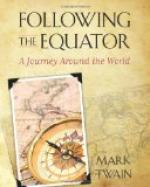Frequently, in Australia, one has cloud-effects of an unfamiliar sort. We had this kind of scenery, finely staged, all the way to Ballarat. Consequently we saw more sky than country on that journey. At one time a great stretch of the vault was densely flecked with wee ragged-edged flakes of painfully white cloud-stuff, all of one shape and size, and equidistant apart, with narrow cracks of adorable blue showing between. The whole was suggestive of a hurricane of snow-flakes drifting across the skies. By and by these flakes fused themselves together in interminable lines, with shady faint hollows between the lines, the long satin-surfaced rollers following each other in simulated movement, and enchantingly counterfeiting the majestic march of a flowing sea. Later, the sea solidified itself; then gradually broke up its mass into innumerable lofty white pillars of about one size, and ranged these across the firmament, in receding and fading perspective, in the similitude of a stupendous colonnade—a mirage without a doubt flung from the far Gates of the Hereafter.
The approaches to Ballarat were beautiful. The features, great green expanses of rolling pasture-land, bisected by eye contenting hedges of commingled new-gold and old-gold gorse—and a lovely lake. One must put in the pause, there, to fetch the reader up with a slight jolt, and keep him from gliding by without noticing the lake. One must notice it; for a lovely lake is not as common a thing along the railways of Australia as are the dry places. Ninety-two in the shade again, but balmy and comfortable, fresh and bracing. A perfect climate.
Forty-five years ago the site now occupied by the City of Ballarat was a sylvan solitude as quiet as Eden and as lovely. Nobody had ever heard of it. On the 25th of August, 1851, the first great gold-strike made in Australia was made here. The wandering prospectors who made it scraped up two pounds and a half of gold the first day-worth $600. A few days later the place was a hive—a town. The news of the strike spread everywhere in a sort of instantaneous way—spread like a flash to the very ends of the earth. A celebrity so prompt and so universal has hardly been paralleled in history, perhaps. It was as if the name Ballarat had suddenly been written on the sky, where all the world could read it at once.
The smaller discoveries made in the colony of New South Wales three months before had already started emigrants toward Australia; they had been coming as a stream, but they came as a flood, now. A hundred thousand people poured into Melbourne from England and other countries in a single month, and flocked away to the mines. The crews of the ships that brought them flocked with them; the clerks in the government offices followed; so did the cooks, the maids, the coachmen, the butlers, and the other domestic servants; so did the carpenters, the smiths, the plumbers, the painters, the reporters, the editors, the lawyers,




